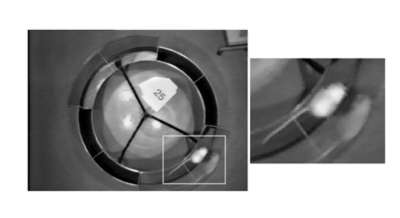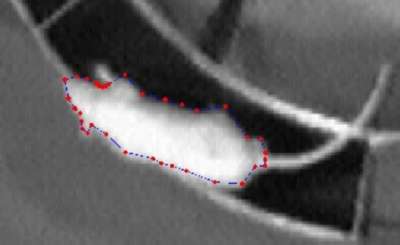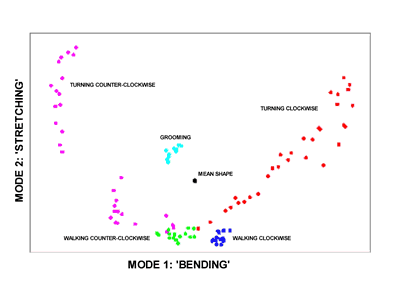
Characterising behavioural phenotypes using automated image analysis
C. Twining1, C. Taylor1, P. Courtney1 and C. Dourish2
1Imaging
Science and Biomedical Engineering, University of Manchester, Manchester,
United Kingdom
2Cerebrus Ltd, Harrow, Middlesex, United Kingdom
The aim of our project is to automate the analysis of studies of rodent behaviour, for use in drug discovery and functional genomics. Systematic behavioural studies have become important in creating animal models of psychiatric and neurological disorders and in investigating their response to pharmacological agents. Recent advances in mouse genetics have created a similar need to characterize the behavioural phenotypes of transgenic mice.

Figure 1. An example monochrome video frame (768X576 pixels) showing an adult Sprague-Dawley rat in the zero maze.
There are a number of well-validated test paradigms such as the elevated zero (Figure 1) and plus mazes, water mazes, dark/light boxes, social interaction analysis, etc. Various automated systems are available which record motion/movement patterns, but the most versatile approach is the analysis of video recordings/live video images of animals in these standardized environments. Many automated systems can track animals and provide position/time data. However, in many cases, behavioural analysis is also required; this commonly involves an experimenter observing and recording data via a computer interface. But this is subjective, qualitative and extremely time-consuming.

Figure 2. Close-up of an example marked-up image from the training set.
We are developing a system that uses Active Shape Models (ASMs [1]); these are deformable models of shape, which are learnt from example images (see Figure 2). The set of shapes seen across the training set is analyzed to extract the modes of variation, providing a compact mathematical description of the shape of the animal and the way it changes. We also model the image profile across the shape boundary. These features allow robust tracking of the explicit object of interest; rather than just detecting movement or changes-from-background in the image, we can focus explicitly on objects that are of the correct shape. The modeling of the profiles also allows us to distinguish, say, between the actual animal and reflections.
The allowed modes of shape variation also provide a compact way of recording the shape variation seen as an animal is tracked. We have found that many characteristic postures can be differentiated using only the first two modes of shape variation (see Figure 3); other postures require more modes, but still a small number. As well as this static recognition of posture, the statistical analysis of shape change over time provides an indicator of behavior.

Figure 3. The values of the first two modes of shape variation plotted for a set of examples of various postures.
Paper presented at Measuring Behavior 2000, 3rd International Conference on Methods and Techniques in Behavioral Research, 15-18 August 2000, Nijmegen, The Netherlands